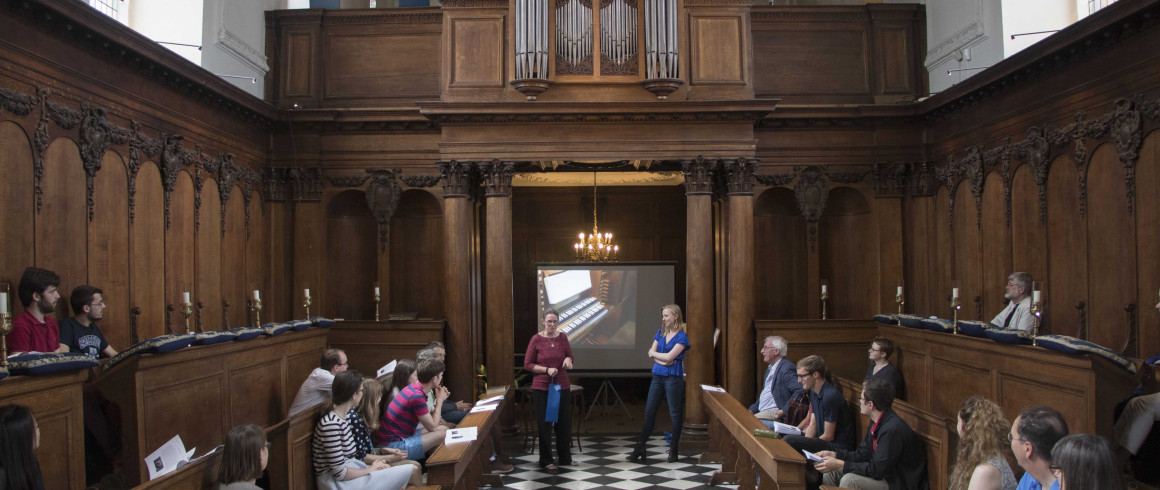Play Like a Girl
Performing the complete organ works of Bach in 24 hours is already a huge undertaking, but this year Director of Music Anna Lapwood wanted to go a step further.
With the theme ‘Play Like a Girl’, this year’s Bach-a-thon was a celebration of the talent of female organists, who are so often out of the limelight. Anna, the first female organ scholar at Magdalen College Oxford, is well aware of the boundaries still in place for female organists and keen to start removing them. An impressive collection of organists gathered to perform Bach’s works on the Pembroke organ, including Libby Burgess, the first female organ scholar at any of the all-male Oxbridge choral foundations, at Christ Church. For Libby, who particularly enjoys Bach, the benefits of the event were two-fold:
[caption id="attachment_32424" align="alignleft" width="300"] Libby Burgess after performing in the Bach-a-thon[/caption]
Libby Burgess after performing in the Bach-a-thon[/caption]
“The music of Bach is absolutely incredible and his organ music is some of his best. The music that I most love playing is Bach, it’s absolutely wonderful. Getting the chance to hear, and play between us, all of it, is amazing…I also think it’s a brilliant thing that it’s shining a light on women organists. Although, as today proves, there are quite a lot of them, there are still far fewer than there are men. You only have to look at the number of female organists in Oxbridge and cathedrals to see that there’s still a real gender imbalance.”
Concern for underrepresentation of female organists was common among the women who performed in the Bach-a-thon. Katharine Pardee is Betts Fellow in Organ Studies at the University of Oxford, Director of Chapel Music at Wadham College, and Lecturer in Music at Corpus Christi College:
“I think Anna is doing great things. Women organists are very underrepresented. There are statistics that say, that in all the London organist recitals 2% are by women. To show that women can play the organ, to hopefully get young girls into it, it’s an amazing thing she’s doing.”
(see Anna’s interview in BBC Music magazine for more statistics about female organists)
Linden Innes-Hopkins – whose daughter Claire also played in the Bach-a-thon – began playing the organ at an early age as ‘organ girl’ in her all-girls school. However, she found her career options constrained by the lack of opportunities for female organists. She is pleased that there are now more pathways for women interested in playing the organ professionally, but thinks there is still a way to go.
“I was really excited by the idea that it was all women. When I went to Music College it became very clear very quickly that there wasn’t really a pathway for lady organists. There were people like Gillian Weir around, and others, but the traditional route – the Cathedral route – the job that Anna and Sarah MacDonald are doing now, it was closed for women.
To be part of something like this, when I look at these young women and see that forty years on, their chances are better - if they work hard and stick at it. That would be my hope. The pieces I have listened to today, there's been some really fine playing. When you look at organ recital series there’s generally a token woman, or no women, but there are lots of really good players out there!”
The need to shine a light on talented female organists is clear, but why play the organ? What draws these musicians to the organ? Rachel Mahon, the first female organist in St Paul’s Cathedral’s 1400 year history, started playing when she was 15 and loves playing the organ with all the challenges it poses:
[caption id="attachment_32423" align="alignnone" width="671"] Anna and Sarah at the end of 24 hours of Bach[/caption]
Anna and Sarah at the end of 24 hours of Bach[/caption]
“It is a joy to play. The organ has so much variety, you can play completely softly, you can play full volume, and everything in between. What a lot of people don’t realise is that the organ imitates a full orchestra. You’ve got trumpet stops, oboe stops, clarinet, strings, flutes, everything, and you can play with all of that or choose one or two. You’re your own ensemble. You play trio sonatas, organ symphonies, and you are the orchestra, or the three instruments in a trio. It’s exciting, and it’s hard on your brain! You have to create new pathways to use your feet and your hands differently to how you mi ght otherwise use them. It’s also slightly an a-musical instrument because it is a machine. The operation of the machine isn’t always musical or graceful, and that is something you have to incorporate into the music. It is a mental and physical workout.”
So where next? What progress is there still to make? According to Linden there’s still a long way to go, but with so many wonderful female organists out there it’s clearly worth keeping up that forward momentum:
“I think probably I would hope, more than anything, that women are seen as a natural part of the organ playing/choir directing world. At the moment I think there’s still a feeling that they’re a bit of a novelty. I would hope that by the time Evie [the youngest organist in the Bach-a-thon] is Sarah’s age, that having women of Directors of Music in the College, and women leading the music in Cathedrals, is seen as normal. That’s where I would hope it would go. There’s a long way to go.”
